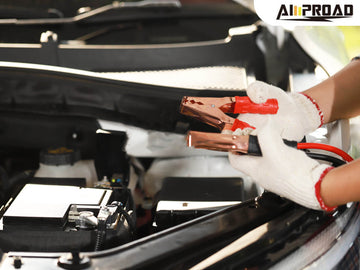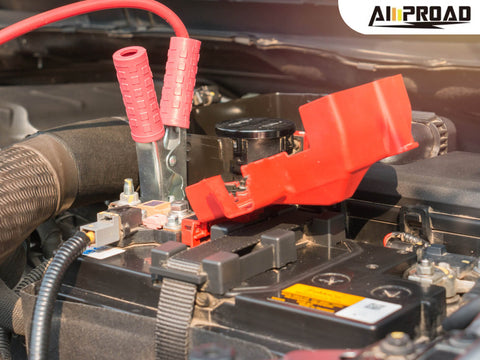
Amps, or amperes, measure the current flow in an electrical system, including jump starters. Understanding the role of amps is crucial for determining the effectiveness of a jump starter. While peak amps represent the maximum power a jump starter can deliver for a short burst, cranking amps indicate the sustained power output required to start an engine. These two measurements differ in their duration and application but collectively influence the overall performance of a jump starter. The amp rating of a jump starter is vital as it determines its capability to provide sufficient power to start a vehicle's engine reliably. Without an adequate amp rating, a jump starter may struggle to deliver the necessary current to initiate the ignition process, leading to failed attempts at jump-starting a vehicle. Therefore, understanding amps and their significance is essential for selecting a jump starter that meets your specific needs and ensures reliable performance when you need it most.
How Do I Determine the Right Amps for My Needs?
Navigating the selection of the right amp rating for a jump starter involves considering several factors. Understanding these elements ensures you choose a jump starter that meets your specific needs and offers reliable performance.
Factors to Consider
When selecting the appropriate amp rating for a jump starter, consider factors such as the size and type of your vehicle, as well as the weather conditions you typically encounter. These factors play a significant role in determining the necessary power output required to effectively jump-start your vehicle's engine.
Vehicle Size and Type
The size and type of your vehicle influence the required amp rating for a jumping starter. Larger vehicles with higher-displacement engines, such as trucks and SUVs, typically require jump starters with higher amp ratings to deliver the necessary power to start the engine. Conversely, smaller cars and sedans may require lower amp ratings for successful jump-starting.
Climate and Temperature
Climate and temperature also play a crucial role in amp selection. In colder climates, engines may require more power to start due to increased resistance in cold engine fluids. Therefore, if you live in a cold climate or frequently encounter low temperatures, consider opting for a jump starter with a higher amp rating to ensure reliable performance in challenging weather conditions.
Understanding the factors that influence amp selection is essential for determining the right amp rating for your jump starter. By considering aspects such as vehicle size and type, as well as climate and temperature conditions, you can ensure you choose a jump starter that provides sufficient power to effectively jump-start your vehicle's engine whenever needed.
What Amp Range Should I Look for Based on My Vehicle Type?

When selecting a jump starter, understanding the appropriate amp range based on your vehicle type is crucial for effective jump-starting. Let's explore the recommended amp ranges for different vehicle types and engine sizes to ensure you choose the right jump starter for your needs.
Recommended Amp Range for Small Cars and Sedans
For small cars and sedans, a car booster pack with an amp range between 400 to 800 amps is generally sufficient to provide the necessary power for jump-starting. Amproad portable jump starters offer reliable options tailored for smaller vehicles, ensuring you have the power needed to start your car's engine with ease.
Amp Requirement for SUVs, Trucks, and Larger Vehicles
Larger vehicles such as SUVs, trucks, and vans typically require jump starters with higher amp ratings due to their larger engine sizes and higher power demands. Amp ranges between 1000 to 2000 amps are recommended for these vehicles to ensure effective jump-starting. Amproad portable jump starters offer robust options designed to meet the amp requirements of larger vehicles, providing the power needed to start engines efficiently.
Specific Amp Options for Diesel Engines and High-Displacement Vehicles
Diesel engines and high-displacement vehicles require jump starters with even higher amp ratings to overcome the additional resistance during starting. Amp ranges between 1500 to 3000 amps are recommended for diesel engines and vehicles with high-displacement engines. Amproad portable jump starters offer specialized options equipped with high amp ratings to meet the unique needs of diesel engines and high-displacement vehicles, ensuring reliable performance in challenging situations.
By selecting a jump starter with the appropriate amp range based on your vehicle type and engine size, you can ensure reliable jump-starting whenever needed. Amproad portable jump starters offer a range of options tailored to different vehicle types and engine sizes, providing peace of mind knowing you have the power needed to start your vehicle's engine in any situation.
How Can I Balance Amps with Other Features in a Jump Starter?

When choosing a jump starter, it's essential to balance the amp rating with other features to ensure you select the right one for your needs. Let's explore how you can achieve this balance and make an informed decision when purchasing a jump starter.
Additional Features to Consider
In addition to the amp rating, there are several other features to consider when choosing a jump starter. Look for options with built-in safety features such as overcharge protection, reverse polarity protection, and short circuit protection to ensure safe and reliable operation. Additionally, consider features like USB ports for charging electronic devices, built-in LED lights for illumination in low-light conditions, and air compressors for inflating tires. These additional features can enhance the versatility and utility of the booster batterie, making it a valuable tool for roadside emergencies and everyday use. The Amproad $99 versatile portable jump starter is an excellent example of a budget-friendly option that offers a range of features to meet various needs.
Impact of Amp Rating on Size, Weight, and Portability
The amp rating of a jump starter can have a significant impact on its size, weight, and portability. Higher amp ratings typically require larger batteries and more robust construction, resulting in bulkier and heavier jump starters. While these high-amp options offer greater power output for jump-starting larger vehicles, they may be less convenient to carry and store. On the other hand, lower-amp jump starters are often more compact and lightweight, making them easier to transport but may have limitations when jump-starting larger vehicles. The Amproad $99 versatile portable jump starter strikes a balance between power and portability, offering a compact and lightweight design without compromising on performance.
Considerations for Budget Constraints and Desired Functionalities
When choosing a jump starter, it's essential to consider your budget constraints and desired functionalities. Higher-amp jump starters with advanced features may come with a higher price tag, while more basic models with lower amp ratings may offer a more affordable option. Evaluate your budget and prioritize the features that are most important to you, whether it's higher power output, additional safety features, or enhanced convenience. The Amproad $99 versatile portable jump starter offers an affordable solution without sacrificing quality or essential features, making it an excellent choice for budget-conscious consumers.
How Do I Ensure Safety and Compatibility with the Amp Rating?

Ensuring safety and compatibility with the amp rating is paramount when selecting a jump starter. Here's how to make sure you choose a jump starter that's safe, reliable, and compatible with your vehicle.
Compatibility with Vehicle's Battery Type and Voltage
Before purchasing a jump starter, check its compatibility with your vehicle's battery type and voltage. Most jump starters are designed to work with standard lead-acid batteries, but some may also be compatible with AGM, gel, or lithium-ion batteries. Additionally, ensure that the jump starter's voltage output matches that of your vehicle's battery. This information can usually be found in the product specifications or user manual.
Built-in Safety Features
Look for jump starters that offer built-in safety features to protect against potential hazards such as overcharging, reverse polarity, and short circuits. Features like reverse polarity protection prevent damage to the jump starter and your vehicle's electrical system if the cables are connected incorrectly. Overcharge protection prevents the battery from being overcharged, which can reduce its lifespan and cause damage. Short circuit protection safeguards against electrical shorts that can occur during jump start.
Quality and Reliability Verification
When choosing a jump starter, it's essential to verify the quality and reliability of the brand and product. Look for reputable brands with a track record of producing high-quality jump starters. Reading customer reviews and ratings can also provide valuable insight into the reliability and performance of a specific jump starter model. Additionally, check for certifications or endorsements from trusted organizations or automotive experts. By doing your research and choosing a trusted brand, you can ensure that you're investing in a jump starter that's safe, reliable, and built to last.
How to Boost a Car with a Jump Starter
In addition to ensuring safety and compatibility with the amp rating, knowing how to boost a car properly with a jump starter is essential. Begin by connecting the positive (red) clamp of the jump starter to the positive terminal of the dead battery, then connect the negative (black) clamp to a metal, unpainted surface on the car's frame. Next, start the vehicle using the jump starter, and once it's running, carefully disconnect the clamps in the reverse order of how they were connected. Always follow the manufacturer's instructions and safety guidelines when using a jump starter to avoid injury or damage to your vehicle.
FAQs
How many amps do I need for a portable jump starter?
The number of amps needed for a portable jump starter depends on the size and type of your vehicle. Generally, smaller cars and sedans require around 400 to 800 amps, while larger vehicles like SUVs and trucks may need between 1000 to 2000 amps. Diesel engines and high-displacement vehicles may require even higher amp ratings, typically ranging from 1500 to 3000 amps. It's essential to choose a jump starter with an amp rating that matches your vehicle's requirements for effective jump-starting.
Is 700 amp jump starter good?
Yes, a 700 amp jump starter can be considered good for starting most small to medium-sized vehicles, including cars, sedans, and some SUVs. However, the suitability of a 700 amp jump starter depends on factors such as the size and type of the vehicle's engine, as well as the weather conditions. It's essential to match the amp rating of the jump starter with the requirements of your specific vehicle for effective jump-starting.


